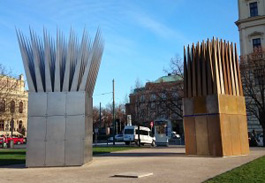
On the anniversary of Palach's act, Prague will unveil his monument
 |
| John Hejduk, House of the Son, House of the Mother; location of the objects MCA architects / Miroslav Cikán and Pavla Melková, in collaboration with Václav Králíček |
Prague - On the anniversary of Jan Palach's self-immolation, who protested against the passivity of people several months after the occupation of his homeland with his provocative act, the city of Prague will unveil his monument. It is the work of American sculptor and architect of Czech origin John Hejduk (1929 to 2000). Currently, there are two sculptures standing on Alšovo nábřeží, near the Faculty of Philosophy where Palach studied. They will be solemnly unveiled on Saturday, January 16.
The monument consists of two approximately six-meter geometric sculptures, from a square pedestal flames emerge. The light one represents the figure of the son-light bearer and the dark one the suffering mother. It is complemented by a memorial plaque with a poem by American writer David Shapiro, Funeral of Jan Palach. He wrote it in 1969 based on a newspaper report about Palach's act, and it itself became an inspiration to John Hejduk.
"It inspired him in the 1980s to an interesting action, where he, along with students in Atlanta, created the first sculpture, which became the initiating object that was paired with another object. After the revolution, he was invited to Prague Castle to realize the paired sculpture, which was then dedicated to the Czechoslovak people and the city of Prague," said architect Miroslav Cikán today, who, along with his colleague Pavla Melková, is the author of the architectural modification of the site around the monument. This is thus the third installation of the sculpture and the only permanent realization of John Hejduk in the world.
In the 1990s, wooden sculptures were erected at the Castle under the names House of the Suicide and House of the Mother of the Suicide. However, over time the sculptures deteriorated and were removed in 2000.
"John Hejduk was my friend, he was a friend of art, he believed in collaboration between art disciplines. Together we constantly strived for a marriage of architecture and other forms of art. I am proud of what was achieved, what was created and that others helped us to realize this marriage between poetry and material art," said Shapiro. "John was a mystic and had a way of thinking that always reminded me of the wind, the wind that blows through Prague," he added.
"This is, after a long time, the most significant realization of a work of art of national significance in the public space of the city," states the director of the Institute of Planning and Development of Prague, Petr Hlaváček, regarding the monument.
Jan Palach, a student of the Faculty of Philosophy at Charles University, self-immolated on January 16, 1969, in protest against the Soviet occupation and against how quickly people resigned to any resistance against it. Palach's act is commemorated in Prague by a memorial plaque in the paving of Wenceslas Square and another on the wall of the Faculty of Philosophy of Charles University. Although John Hejduk dedicated his work to Prague more than twenty years ago, he was unable to build a significant monument to the provocative and unprecedented act of the Prague student in the year when people commemorated its 45th anniversary, nor when they marked 25 years since the fall of the totalitarian regime.




